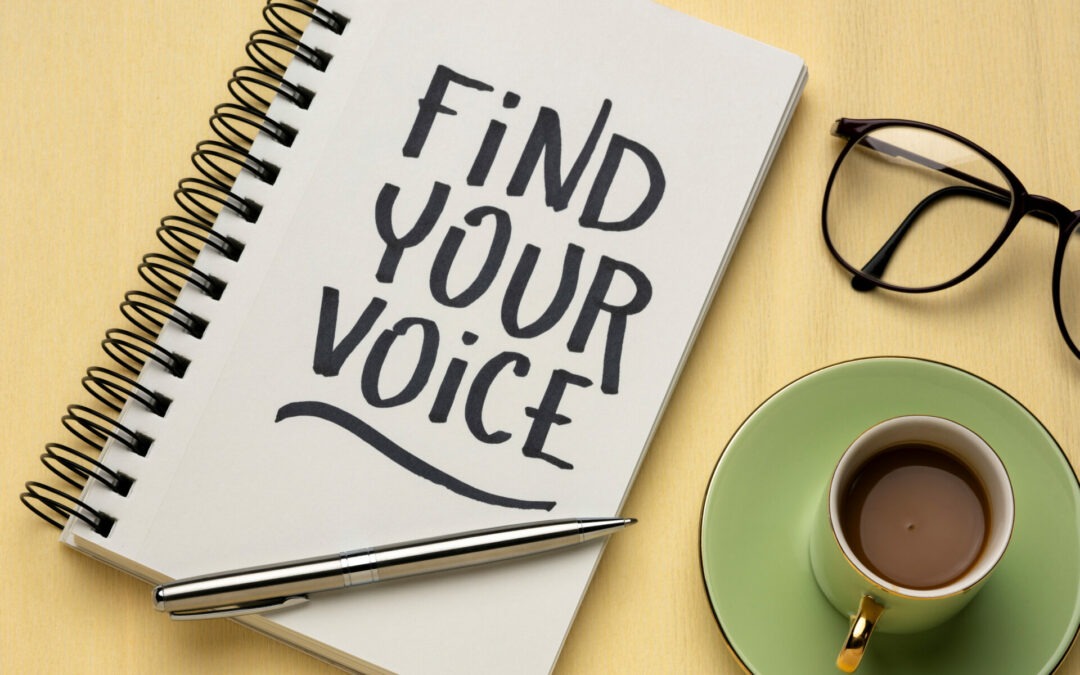If your brand doesn’t have a voice, then you’re going to have a big struggle on your hands to make it work. Why? because your brand voice is how you speak to your customers. It’s your language of love, it’s your lingo that makes them go “Bingo! They GET me!”
And it’s how you share your company’s values and motivations. When you hit your brand voice out of the park and make it great, it means you can connect with, engage and get your audience to believe in what you do.
And THAT of course leads to sales.
Now, a brand voice is not about the creation of a non=-human voice. It’s the very opposite. It;s about giving your business pizazz and personality. You use it to position yourself as an easily identified and authoritative source for your area of expertise.
And it’s about being consistent – so when I see your brand voice as a customer, it’s exactly the same on your website, in your emails, and on your social media.

Brand Voice And Speaking Your Client’s Lingo
Brand voice is the way you talk to your customers and your can define it through your brand’s style of communication.
You are speaking to your target audience, and it can have any style, and be on pointe when it comes to your persona. So your brand voice can be authoritative, playful, intellectual, or even kind or fun.
Just as you communicate in a specific way with your family, and different to your friends, there’s also a way to communicate specifically with your customer base.
And the reason this is so important is because consumers invest more in brands when there is an emotional connection.
Why? Well do you care when you are reading a load of old codswallop that doesn’t have any impact on your emotionally?
It’t not really about what you say, it’s how you say it. So your brand voice has to flow through everything that is written for your biz, whether its email, website copy, press releases, packaging, ads, and social media platforms.
Examples of Successful Brand Voice
If you want to get your head around how brand voice works here are some good examples.
Glossier is a wellness and beauty brand that describes itself as a “people-powered beauty ecosystem”. They are all about modern women being at one with beauty through empowerment and self-care.
They frequently use bright visuals with a feminine skew, and bold phrases. Amd they don’t mind about getting vulnerable on their social posts.
Another great example is Nike. Their message is inspiring, positive, and powerful. There is no mistaking their tone of voice which is motivating and encouraging.
So it’s not just about buying their products, it’s also about going out and getting active in them.
Apple is another brand that’s nailed it with their copy. They not only make everyone feel welcome, and also make those who purchase feel special when they buy their products.
Why? It’s all about confidence, intimacy and quality.
Imagine Your Brand Is A Person
How would you describe the personality of your brand to someone? How would you describe your competitors as people as well?
Does your brand have the following character traits?
Passionate
Quirky
Then you can start dialling into the specifics of what that means in more detail. For example
Passionate – expressive, enthusiastic, heartfelt, action-oriented
Quirky – irreverent, unexpected, contrarian
Authentic – genuine, trustworthy, engaging, direct
Look at All Your Content Together For Brand Voice
Your brand voice should be exactly the same across every single piece of content you have. So take a look at everything you use to engage with your audience.
That includes everything from emails, to your website, to your social posts, to you lead magnets, to your newsletters. What are your competitors doing with theirs? Where do you feel they have strengths and weaknesses.
Research Your Target Market
You speak differently to your parents to how you speak to your friends. So you need to know how to speak to your audience. And to do that you need to know who they are.
Look at past customers – case studies are a great way to really get inside your client’s minds. You can mine all sorts of great information down to what words they use.
What are the problems your customers get solved by you? Get specific. If you create a personal product for women, are those women mainly parents, and if they are, what age are they and how old are their children. Do they want self-care or want to look good using your product?
Use your current audience and get the following information:
Demographics– That includes users’ age, gender, marital status, occupation, income, race, and educational background, among other traits.
Psychographics– What your users’ interests and hobbies? Their goals and frustrations? Understanding their psychographics requires getting inside their heads.
Define What is Good and What Isn’t
If you want to have a clear brand voice, you need to know what it’s not as well as what it is.
So, you can be casual, but not lazy. Playful, but not immature.
Make a list of what you see it is and it isn’t.
Make a list of do’s and don’ts so you can define what your content should and shouldn’t be. So if you are being ‘playful’:
DO
- offer tasteful jokes
- include GIFs from popular media
- tell entertaining stories
DON’T
- make too many pop culture references
- poke fun at the customer
- exaggerate for effect
Don’t Copy Others
They say imitation is the sincerest form of flattery. But when it comes to brand voice, you want to stand out from the crowd.
Of course, you can study your competition, but don’t try and steal their style. You should be you!
An example of this was when Pepsi used Kendall Jenner in a commercial in 2017. It was seen as downplaying the struggle of real-life activists. And many observers saw the comparison with one of the most successful Tv ads of all time by Coca-Cola.
Their 1971 peace-promoting television ad had the catchy song “I’d Like to Buy the World a Coke”—and it’s one of the most famous ads of all time.
Conclusion
The main thing to remember about brand voice is that it doesn’t just stay the same. It’s always good to have a refresh and look at how your brand is resonating with your audience. Mine new research and see if you are still speaking their language!
If you would like a free brand message audit of two of your online platforms, you can do that by clicking on this link here.



Recent Comments